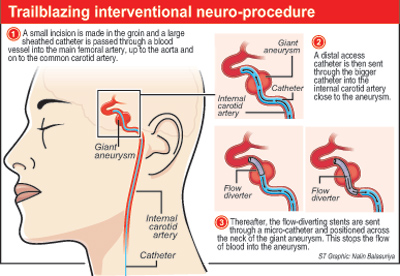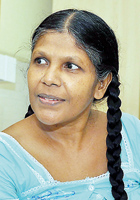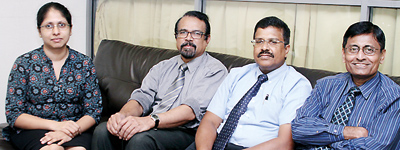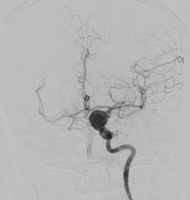Stopping a virtual time-bomb in the brain
Sunethra Malaviyaarachchi from Anuradhapura has had a near-miss with death. When we met her last month, however, this 54-year-old teacher is all smiles and about to go home from hospital, back to her husband and three sons. If not for a brand new neuro-interventional procedure in Sri Lanka performed at the Central Hospital in Colombo, the outcome in Sunethra’s case may not have been what it is.
For, she had a virtual time-bomb in the brain. A giant, wide-necked aneurysm was ticking away inside her head, the rupture of which without warning due to coughing or straining, could bring about death. The only answer was ‘Endovascular management of a giant, wide-necked aneurysm using a flow-diverter’, a new method even universally, which had never been attempted in Sri Lanka, MediScene learns (see graphic).

This was the procedure performed on Sunethra by a joint neuro-vascular team comprising Consultant Interventional Radiologists Dr. Nihal Wijewardena and Dr. Lakmalie Paranahewa, Consultant Neurosurgeons Dr. Sunil Perera and Dr. Jaliya Lokuketagoda and Consultant Anaesthetist Dr. Lushantha Padmasiri at the Central Hospital, on August 15.
When Sunethra came down with a viral fever last April followed by a strange but excruciating pain inside her head, she assumed it was due to an ear-operation done in 2006 to repair her ear-drum. She sought treatment from Consultant Ear, Nose and Throat Surgeon, Dr. Upul Abeysundera, at the Anuradhapura General Hospital. When the feeling of floating persisted, he referred her to Consultant Neurosurgeon Dr. Punsith Gunawardene.
A CT scan followed at the Anuradhapura Hospital, giving a glimpse into the “goings-on” in her brain and it was Dr. Gunawardene who explained to Sunethra that a blood vessel had ballooned. It was like an “imbul kiri-buth gediyak”, explains Sunethra, with things happening quickly thereafter and Dr. Gunawardene promptly referring her for endovascular management to Dr. Nihal Wijewardena, as it was an emergency.

Sunethra ready to go home
In Sri Lanka, at the time of this diagnosis, only smaller aneurysms were being handled, coiling being the answer. This giant, wide-necked aneurysm of the intra-cranial internal carotid artery behind Sunethra’s left eye required a higher intervention, MediScene learns.
Hope for a desperate Sunethra came in the form of a promise that the new procedure using a flow-diverter and not one but two stents would be performed by the Central team in August.
This would be possible only because the state-of-the-art Biplane Digital Subtraction Angiography Unit dedicated for neuro-interventions is available at the Central.
The team strongly advised Sunethra to be extremely careful. “Don’t cough or strain,” she was told in no uncertain terms, for any of these could lead to the rupture of the aneurysm and sure death.
The three-hour procedure took place on August 15.
The explanation from Dr. Perera is simple. There is no other option but to use a flow-diverter in the case of a giant, wide-necked aneurysm, to save a patient without any “deficit”. Deficit would mean harm to the patient during the procedure, MediScene understands, for the other would be open-brain surgery to close the aneurysm which would entail only blocking the artery which provides it blood. This has a 50% risk of the patient suffering a stroke.
According to Dr. Wijewardena the complications in the flow-diverter procedure could be a rupture of the aneurysm or dislodgement of the stent. “But these are rare,” he says. Dr. Paranahewa who performed the procedure on Sunethra explains that usually a smaller aneurysm is coiled (the balloon or aneurysm sac packed with coils) to prevent it from receiving blood, growing, rupturing and causing a bleed. But in the case of Sunethra this was not possible as the aneurysm bulge was on both sides of the blood vessel.

The medical team which created history (from left) Dr. Lakmalie Paranahewa, Dr. Nihal Wijewardena, Dr. Sunil Perera and Dr. Jaliya Lokuketagoda. Pix by Indika Handuwala
This is where the stents came in handy to allow the flow of blood through the artery but prevent blood from going into the aneurysm. As the neck was wide, one stent would just not do, she says. Pointing out that the procedure is tricky, Dr. Paranahewa explains that the application of the flow-diverter was tried out on a model before the team applied the technique on Sunethra.
On hand as a resource person during the procedure was the Head of Department of Neuroradiology of Sri Ramachandra Medical College in Chennai, Prof. Santhosh Joseph who had tried out the two-stent procedure successfully in India.
Adds Dr. Wijewardena that the most difficult part is to navigate the wire across the aneurysm, because getting into the aneurysm bulge is easy, but finding the pathway out is challenging.
What’s an aneurysm?
The formation of aneurysms could be due to genetics with some people’s blood vessels being thinner and weaker while they could also be triggered by cholesterol or hypertension (high blood pressure). Aneurysms do not seem to be a rare condition, but a common problem, the Central Hospital’s team of doctors explains to MediScene, pointing out that they see about two to three aneurysms a week.

The statistics are not only disturbing but also chilling – One in four (25%) who develop an aneurysm will not reach the hospital but die when it ruptures.
Of the balance, in another 25% there will be a second bleed within a day and half of this group will die. Of the remaining group from the original number, 25% will have another bleed within 10-14 days, 25% within a month and the rest within a year.
A complication of a ruptured aneurysm is a stroke and paralysis, the team says, reiterating that proper diagnosis is vital. The very first indication of an aneurysm is a “sentinel headache”, says Dr. Sunil Perera, explaining that it is a thunderclap headache.
The patient feels as if “mole ethule hena gahanawa” and describes it as the “biggest” or “worst” headache that has ever been experienced. It may be accompanied by vomiting, loss of consciousness and fits (seizures). Any sudden severe headache needs to be investigated immediately by a doctor and the patient referred to an expert as it may be a life-and-death situation, MediScene understands.
Advising anyone who has a thunderclap headache to lie still in bed until taken to a doctor as soon as possible, the team says, any lifting or straining could create a sudden surge of blood pressure, causing a rupture of the aneurysm. This is why the toilet is a common place where people with aneurysms collapse.
Pointing out the difference between a migraine attack and a sentinel headache caused by an aneurysm, Dr. Perera says that usually one knows when a migraine is coming on. It worsens gradually along with visual disturbances.
comments powered by Disqus

